NURS 4220A LC4005A Improving Patient Quality and Safety Assessment Example
 NURS 4220A LC4005A Improving Patient Quality and Safety Assessment Assignment
NURS 4220A LC4005A Improving Patient Quality and Safety Assessment Assignment
NURS 4220A LC4005A Improving Patient Quality and Safety Assessment Assignment Brief
Course: NURS 4220A – Leadership Competencies in Nursing and Healthcare
Assignment Title: NURS 4220A LC4005A Improving Patient Quality and Safety Assessment Assignment
Assignment Instructions Overview
This assignment involves completing a comprehensive paper, developing a quality improvement storyboard, and submitting a practice experience documentation form signed by the health professionals who collaborated with you. The submission length is a 4- to 5-page paper, a quality improvement storyboard, and a completed practice experience documentation form.
Understanding Assignment Objectives
The primary objective of this assignment is to demonstrate your ability to apply quality improvement processes and tools to enhance patient outcomes. You will identify a data-driven quality improvement practice problem, explain its importance in nursing practice, describe relevant quality improvement tools, justify their use, and apply the PDSA (Plan-Do-Study-Act) cycle to your identified problem.
The Student’s Role
As a student, you are expected to engage in self-assessment and interact substantively with your Faculty Subject Matter Expert (SME). You will synthesize evidence-based literature to support your quality improvement project, develop a storyboard to visually summarize your initiative, and document your practice experience with appropriate professional sign-off.
Competencies Measured
- Identification and Description of Quality Improvement Practice Problems:
- Articulate a data-driven quality improvement practice problem.
- Synthesize scholarly evidence to support the significance of the identified problem.
- Application of Quality Improvement Tools:
- Describe and justify the use of specific quality improvement tools.
- Explain the application of the PDSA cycle to the identified problem.
- Development of Quality Improvement Storyboard:
- Create a clear and comprehensive storyboard summarizing the quality improvement initiative.
- Professional Documentation:
- Complete and submit the practice experience documentation form with the mentor’s signature to verify participation.
- Professional Writing:
- Demonstrate clear, logical, and well-organized writing with proper APA citations and references.
- Ensure originality, context-awareness, and adherence to scholarly tone.
You Can Also Check Other Related Assessments for the NURS 4220A – Leadership Competencies in Nursing and Healthcare Course:
NURS 4220A LC4001A Leadership for Organizational Culture and Growth Assignment Example
NURS 4220A LC4002A Healthcare Quality Nursing Assignment Example
NURS 4220A LC4003A Quality Improvement Processes Nursing Assignment Example
NURS 4220A LC4004A Quality Improvement Tools Nursing Assignment Example
NURS 4220A LC4005A Improving Patient Quality and Safety Assessment Example
Part 1: Comprehensive Paper
Data-Driven Quality Improvement Practice Problem
Medication errors are a significant cause of morbidity and mortality in hospitals. These errors, especially the omission of prescribed medicines, adversely affect patient care and have a monetary impact on healthcare systems. Prescribing errors are a type of medication error characterized by unintended significant reductions in the timely and efficient treatment of patients, thus increasing the risk of harm compared to accepted practice (Basey et al., 2014). Medication errors encompass any error that occurs in the medication use process (Wittich et al., 2014).
Importance of Quality Improvement in Nursing Practice
The quality improvement of medication errors is crucial for enhancing the quality of care in population health, ensuring effective medication administration by nurses, and improving overall performance. The primary goal is to uphold the ethical principle of “do no harm.” Patients trust nurses to provide high-quality care and to ensure their safety. While errors are rarely intentional, they can occur quickly, even with minor interruptions. Multiple factors contribute to medication errors, but the most important aspect is to be prepared and address these errors as quickly as possible. Medication errors can have fatal consequences, and there can be legal implications if such errors are concealed. The purpose of quality improvement is to discuss the ethical and legal implications of disclosure and non-disclosure and to take swift action to correct errors. Nurses must do everything in their power to prevent medication errors by following the five rights of medication administration, verifying orders with the prescribing physician, and questioning any unclear orders.
Quality Improvement Tools
Since the Institute of Medicine (IOM) reported that up to 98,000 people die annually due to medical errors and safety breaches, the healthcare community has focused extensively on improving safety, efficiency, and quality (Wiler et al., 2015). With the principles of beneficence and non-maleficence in mind, healthcare providers are guided to do what is best for patients and to avoid harm.
To address medication errors effectively, organizations should create an environment with heightened awareness about medication safety and a commitment from leadership to address related issues and processes. The implementation of new technology or the enhancement of existing systems should be part of the organization’s overall strategy to create a culture of safety. Technological solutions alone are not sufficient; they should be integrated into the organization’s broader medication safety strategy.
Specific Quality Improvement Tools and Their Utility
The following quality improvement tools are essential for interpreting data and addressing medication errors:
- Process Mapping: Understanding the medication use process within the organization, including how medications are ordered, dispensed, and administered in patient care areas.
- Safety Protocols: Establishing robust safety protocols to prevent medication errors, such as verifying patient wristbands and recording allergy information.
- Continuous Assessment: Conducting regular assessments to identify opportunities for improvement and areas where medication errors occur most frequently.
- Education Programs: Implementing educational programs for both patients and staff on medication safety.
- Technological Assessments: Conducting baseline and follow-up assessments to identify organizational needs and provide guidance in selecting technological solutions.
- Community Preparation: Preparing the hospital community for medication safety initiatives, including the use of technology.
- Gap Analysis: Identifying gaps and deficiencies in the current information infrastructure and taking inventory of existing systems and capabilities.
- Feature Identification: Determining the features and capabilities required to support medication safety processes.
- Product Evaluation: Evaluating products and features that would add value to the organization in preventing medication errors.
These tools are particularly useful because they provide a structured approach to understanding and addressing the complex processes involved in medication administration. They help identify critical points where errors are likely to occur and offer solutions to mitigate these risks.
Applying the PDSA Quality Improvement Process
The Plan-Do-Study-Act (PDSA) cycle is a systematic series of steps for gaining valuable learning and knowledge for the continual improvement of a product or process. Applying the PDSA cycle to the quality improvement of medication errors involves:
- Plan: Identify specific areas where medication errors frequently occur and develop a plan to address these issues. This includes setting clear objectives, identifying necessary resources, and defining key performance indicators (KPIs).
- Do: Implement the plan on a small scale to test its effectiveness. This might involve a pilot project in a specific department or with a particular group of medications.
- Study: Collect and analyze data to determine whether the changes are leading to improvement. This includes comparing the current data with baseline measurements and assessing the impact on medication error rates.
- Act: Based on the analysis, decide whether to adopt, adapt, or abandon the changes. If successful, implement the changes on a larger scale; if not, refine the plan and repeat the cycle.
Supporting this plan with scholarly evidence ensures that the strategies are grounded in best practices and proven methodologies. A literature review of at least five scholarly sources will provide the necessary evidence to support the effectiveness of the PDSA cycle in improving medication safety.
References
Basey, A. J., Kennedy, T. D., Mackridge, A. J., & Wilson, K. A. (2014). Quality improvement of prescribing errors: Evaluation of a strategy for improving prescription accuracy. Journal of Patient Safety, 10(1), 5-9.
Wiler, J. L., Welch, S., Pines, J., Schuur, J., Jouriles, N., & Stone-Griffith, S. (2015). Quality improvement strategies to improve medication safety in hospitals. Journal of Emergency Nursing, 41(2), 150-159.
Wittich, C. M., Burkle, C. M., & Lanier, W. L. (2014). Medication errors: An overview for clinicians. Mayo Clinic Proceedings, 89(8), 1116-1125.
Part 2: Quality Improvement Storyboard
Slide 1: Summary of Quality Improvement Project
Title: Quality Improvement of Medication Error
- Objective: To reduce the incidence of medication errors in the hospital setting by implementing comprehensive safety protocols and utilizing technological solutions.
- Plan: Identify critical points in the medication use process where errors frequently occur, establish safety protocols, and integrate technological solutions to prevent errors.
- Do: Conduct a pilot project in the emergency department to test the effectiveness of the new safety protocols and technological solutions.
- Study: Collect and analyze data on medication error rates before and after the implementation of the pilot project.
- Act: Based on the analysis, refine the safety protocols and technological solutions, and implement them hospital-wide.
Slide 2: References
Basey, A. J., Kennedy, T. D., Mackridge, A. J., & Wilson, K. A. (2014). Quality improvement of prescribing errors: Evaluation of a strategy for improving prescription accuracy. Journal of Patient Safety, 10(1), 5-9.
Wiler, J. L., Welch, S., Pines, J., Schuur, J., Jouriles, N., & Stone-Griffith, S. (2015). Quality improvement strategies to improve medication safety in hospitals. Journal of Emergency Nursing, 41(2), 150-159.
Wittich, C. M., Burkle, C. M., & Lanier, W. L. (2014). Medication errors: An overview for clinicians. Mayo Clinic Proceedings, 89(8), 1116-1125.
Part 3: Practice Experience Documentation Form
Please ensure the form is filled out and signed by your mentor, confirming your active and affirmative participation in the practice experience. The form should indicate that you have sufficiently engaged in developing and implementing the Quality Improvement Project.
Detailed Assessment Instructions for the NURS 4220A LC4005A Improving Patient Quality and Safety Assessment Assignment
NURS 4220A LC4005A Improving Patient Quality and Safety Assessment
LC4005A Improving Patient Quality and Safety Assessment
LC4005A Assessment Instructions
Review the details of your assessment including the rubric. You will have the ability to submit the assessment once you submit your required self-assessments and engage with your Faculty Subject Matter Expert (SME) in a substantive way about the competency.
Overview
In this Assessment, you will complete a comprehensive paper and develop a quality improvement storyboard for your Quality Improvement Project. You will also submit a completed practice experience documentation form signed by the health professionals who collaborated with you in developing the Quality Improvement Project. LC4005A Improving Patient Quality and Safety Assessment
Submission Length: 4- to 5-page comprehensive paper and a quality improvement storyboard, and a completed practice experience documentation form.
Instructions
To complete this Assessment, do the following:
- Be sure to adhere to the indicated assignment length.
- Access the following:
- Review the following website regarding the use of a quality improvement storyboard and provide examples of the information and interventions that need to be included in a storyboard: Multi-State Learning Collaborative. (n.d.). Guidelines for the development of quality improvement storyboards.
- Your deliverables for this Assessment include:
- Part 1. Comprehensive Paper
- Part 2. Storyboard
- Part 3. Practice Experience Documentation Form
Before submitting your Assessment, carefully review the rubric. This is the same rubric the SME will use to evaluate your submission and it provides detailed criteria describing how to achieve or master the Competency. Many students find that understanding the requirements of the Assessment and the rubric criteria help them direct their focus and use their time most productively.
Rubric
All submissions must follow the conventions of scholarly writing. Properly formatted APA citations and references must be provided where appropriate. Submissions that do not meet these expectations will be returned without scoring.
This Assessment requires submission of three files. Save your first file as LC4005A_firstinitial_lastname_part1 (for example, LC4005A_J_Smith_part1); save your second file as LC4005A_firstinitial_lastname_part2 (for example, LC4005A_J_Smith_part2); save your third file as LC4005A_firstinitlal_lastname_part3 (for example, LC4005A_J_Smith_part3)..
You may submit a draft of your assignment to the area to check for authenticity. When you are ready to upload your completed Assessment, use the Assessment tab on the top navigation menu.
Important Note: As a student taking this Competency, you agree that you may be required to submit your Assessment for textual similarity review to Turnitin.com for the detection of plagiarism. All submitted Assessment materials will be included as source documents in the Turnitin.com reference database solely for the purpose of detecting plagiarism of such materials. Use of the Turnitin.com service is subject to the Usage Policy posted on the Turnitin.com site.
Click each of the items below for more information on this Assessment.
Your Comprehensive Paper provides the theoretical background to support your quality improvement practice problem and Quality Improvement Project. Many of the elements of this paper are parts of your Competency Assessments from previous competencies in this area of expertise. In a 4- to 5-page paper, address the following:
- Describe the data-driven quality improvement practice problem you identified. (Use your submission and the SME feedback from LC4001A and LC4002A to help complete this section.)
- Explain the importance of the quality improvement practice problem you identified for nursing practice. Support your explanation by synthesizing evidence-based literature found through a literature search, using a minimum of five (5) scholarly sources. (Use your submission and the SME feedback from LC4002A to complete this section)
- Describe the quality improvement tools that will aid in the interpretation of the data that will support addressing the quality improvement practice problem you identified. (Use your submission and the SME feedback from LC4003A and LC4004A to help complete this section.)
- Explain why these quality improvement tools are most useful in addressing your quality improvement practice problem. (Use your submission and the SME feedback from LC4004A to help complete this section.) LC4005A Improving Patient Quality and Safety Assessment
- Explain how you would apply the PDSA quality improvement process to your quality improvement practice problem. Support your plan by synthesizing a minimum of five (5) pieces of scholarly evidence found through a literature search. (Use your submission and the SME feedback from LC4003A to help complete this section.)
Be sure to integrate capstone-level writing guidelines in the completion of your Comprehensive Paper. This is an expectation of the completion of this program and is a requirement for future study in graduate school.
A quality improvement storyboard is required for this Competency. The Practice Experience Project Storyboard is a brief, visual summary of a completed Quality Improvement initiative. The storyboard highlights key aspects of a quality improvement effort by documenting the Practice Experience Project from beginning to end. Note that you do not have to develop different information. You are presenting the same information that you wrote about in your paper. The Competency template uses a PowerPoint format to complete this assignment. The first slide is the summary of the Quality Improvement Project; the second slide is the reference page. Choose the most pertinent information from your Comprehensive Paper to complete the Storyboard. A template is provided to guide you as you develop your storyboard.
Your Practice Experience Documentation Form should be completed and signed by your mentor. In order to successfully complete this element, your mentor must indicate that you participated sufficiently in the practice experience.
Resources – LC4005A Improving Patient Quality and Safety Assessment
Chapter 20, “Managing Costs and Budgets” (pp. 358–376) Chapter 23, “Managing Quality and Risk” (pp. 407–427) Yoder-Wise, P. (2019). Leading and managing in nursing (7th ed.). Mosby Elsevier.
Chapter 10, “Managing Use of Health Care Resources” (pp. 249–280) Spath, P. (2018). Introduction to healthcare quality management (3rd ed.). Health Administration Press.
Melnyk, B. M. (2016). Improving healthcare quality, patient outcomes, and costs with evidence-based practice. https://nursingcentered.sigmanursing.org/features/more-features/Vol42_3_improving-healthcare-quality-patient-outcomes-and-costs-with-evidence-based-practice
Tschannen, D., Aebersold, M., Kocan, M. J., Lundy, F., & Potempa, K. (2015). Improving patient care through student leadership in team quality improvement projects. Journal of Nursing Care Quality, 30(2), 181–186. doi:10.1097/NCQ.0000000000000080
Minnesota Department of Health. (n.d.). Quality improvement storyboard. https://www.health.state.mn.us/communities/practice/resources/phqitoolbox/qistoryboard.html
Chapter 6, “Performance Improvement Tools: Quality Storyboards” (pp. 169–170) Spath, P. (2018). Introduction to healthcare quality management (3rd ed.). Health Administration Press.
LC4005: Improving Patient Quality and Safety: Apply quality improvement processes and tools as a scholar- practitioner to improve patient outcomes. Assessment Rubric
| Rubric Criteria | Does Not Meet Expectations | Meets Expectations | Exceeds Expectations |
| Module 1: Applying Quality Improvement Processes to Practice | |||
| Describe the data- driven quality improvement practice problem you identified. | Response does not adequately describe the data-driven quality improvement practice problem that you identified. LC4005A Improving Patient Quality and Safety Assessment | Response adequately describes the data-driven quality improvement practice problem that you identified. | Response clearly and completely describes the data-driven quality improvement practice problem that you identified. |
| Learning Objective 1.1: Describe data-driven quality improvement practice problems | |||
| Explain the importance of the quality improvement practice problem you identified for nursing practice. | Response does not adequately explain the importance of the quality improvement practice problem you identified for nursing practice. | Response adequately explains the importance of the quality improvement practice problem you identified for nursing practice. | Response clearly and completely explains the importance of the quality improvement practice problem you identified for nursing practice. |
| Learning Objective 1.2: Explain the importance of quality improvement practice problems in nursing practice | |||
| Support your | Response does not | Response adequately | Response clearly and |
| explanation by | adequately support your | supports your explanation | completely supports your |
| synthesizing evidence- | explanation by | by synthesizing evidence- | explanation by |
| based literature found | synthesizing evidence- | based literature found | synthesizing evidence- |
| Rubric Criteria | Does Not Meet Expectations | Meets Expectations | Exceeds Expectations |
| through a literature search, using a minimum of five (5) scholarly sources.
Learning Objective 1.3: Synthesize scholarly evidence |
based literature found through a literature search or does not use a minimum of 5 scholarly sources. | through a literature search, using a minimum of 5 scholarly sources. LC4005A Improving Patient Quality and Safety Assessment | based literature found through a literature search, using a minimum of 5 scholarly sources. |
| Describe the quality improvement tools that will aid in the interpretation of the data that will support addressing the quality improvement practice problem you identified.
Learning Objective 1.4: Describe quality improvement tools used to interpret data related to quality improvement practice problems |
Response does not adequately describe the quality improvement tools that will aid in the interpretation of the data that will sill support addressing the quality improvement practice problem you identified. | Response adequately describes the quality improvement tools that will aid in the interpretation of the data that will sill support addressing the quality improvement practice problem you identified. | Response clearly and completely describes the quality improvement tools that will aid in the interpretation of the data that will sill support addressing the quality improvement practice problem you identified. |
| Explain why these quality improvement tools are most useful in addressing your quality improvement practice problem. | Response does not adequately explain why these quality improvement tools are most useful in addressing your quality improvement practice problem. | Response adequately explains why these quality improvement tools are most useful in addressing your quality improvement practice problem. | Response clearly and completely explains why these quality improvement tools are most useful in addressing your quality improvement practice problem. |
| Rubric Criteria | Does Not Meet Expectations | Meets Expectations | Exceeds Expectations |
| Learning Objective 1.5: Justify the use of quality improvement tools to address quality improvement practice problems | |||
| Explain how you would apply the PDSA quality improvement process to your quality improvement practice problem.
Learning Objective 1.6: Apply quality improvement processes to quality improvement practice problems |
Response does not adequately explain how you would apply a quality improvement process to your quality improvement practice problem. | Response adequately explains how you would apply a quality improvement process to your quality improvement practice problem. | Response clearly and completely explains how you would apply a quality improvement process to your quality improvement practice problem. |
| Support your plan by synthesizing a minimum of five (5) pieces of scholarly evidence found through a literature search.
Learning Objective 1.7: Synthesize scholarly evidence relating to quality improvement plans |
Response does not adequately support your plan by synthesizing a minimum of 5 pieces of scholarly evidence found through a literature search. | Response adequately supports your plan by synthesizing a minimum of 5 pieces of scholarly evidence found through a literature search. | Response clearly and completely supports your plan by synthesizing a minimum of 5 pieces of scholarly evidence found through a literature search. |
| Rubric Criteria | Does Not Meet Expectations | Meets Expectations | Exceeds Expectations |
| Module 2: Developing a Storyboard | |||
| Create a storyboard for your quality improvement practice problem.
Learning Objective 2.1: Create storyboards to display plans for quality improvement practice problems |
Response does not adequately create a storyboard for your quality improvement practice problem. LC4005A Improving Patient Quality and Safety Assessment | Response adequately creates a storyboard for your quality improvement practice problem. | Response creatively, thoughtfully, and completely creates a storyboard for your quality improvement practice problem. |
| Complete Practice Experience Documentation Form.
Learning Objective 2.2: Justify successful practice experience through documentation form |
Practice Experience Documentation Form is not signed and complete, or affirmative participation is not indicated. | Practice Experience Documentation Form is signed and complete, and affirmative participation is adequately indicated. | Practice Experience Documentation Form is signed and completed, and affirmative participation is exceeded as indicated by the mentor. |
Professional Skills Assessment
| Professional Writing | |||
| Professional Writing: | Content contains significant | Content contains few | Content is free from |
| Clarity, Flow, and | spelling, punctuation, and/or | spelling, punctuation, | spelling, punctuation, and |
| Organization | grammar/syntax errors. | and/or grammar/syntax | grammar/syntax errors. |
| Writing does not | errors. Writing | Writing demonstrates | |
| demonstrate adequate | demonstrates adequate | appropriate sentence and | |
| sentence and paragraph | sentence and paragraph | paragraph structure. | |
| structure and requires | structure and may require | Content presented is clear, | |
| additional | some editing. Content | logical, and well-organized. | |
| editing/proofreading. Key | presented is satisfactorily | ||
| sections of presented | clear, logical, and/or | ||
| content lack clarity, logical flow, and/or organization. | organized, but could benefit from additional editing/revision. | ||
| Professional Writing: Context, Audience, Purpose, and Tone | Content minimally or does not demonstrate awareness of context, audience, and/or purpose. Writing is not reflective of professional/scholarly tone and/or is not free of bias.
Style is inconsistent with the professional setting/workplace context and reflects the need for additional editing. |
Content demonstrates satisfactory awareness of context, audience, and purpose. Tone is adequately professional, scholarly, and/or free from bias, and style is mostly consistent with the professional setting/workplace context. LC4005A Improving Patient Quality and Safety Assessment | Content clearly demonstrates awareness of context, audience, and purpose. Tone is highly professional, scholarly, and free from bias, and style is appropriate for the professional setting/workplace context. |
| Professional Writing: Originality, Source Credibility, and Attribution of Ideas | Content does not adequately reflect original writing and/or paraphrasing. Writing demonstrates inconsistent adherence to reference requirements, including the use of credible evidence to support a claim, with appropriate source attribution (when applicable) and reference. There are numerous and/or significant errors. | Content adequately reflects original writing and paraphrasing. Writing demonstrates adequate adherence to reference requirements, including the use of credible evidence to support a claim, with appropriate source attribution (when applicable) and references. There are one or two minor errors. | Content reflects original thought and writing and proper paraphrasing.
Writing demonstrates full adherence to reference requirements, including the use of credible evidence to support a claim, with appropriate source attribution (when applicable) and references. |
Make Your Nursing Academic Journey Truly Fulfilling with Our Expert Nursing Assignment Writing Help!
Feeling overwhelmed by the demands of your nursing essays and assignments? Don’t let stress derail your academic success. nursingcustomwriting.com is your partner in navigating the challenges of nursing studies. Our reliable nursing paper writing services are tailored to lighten your assignment load and ensure your journey in nursing education is not just manageable, but truly fulfilling.
Expertise That Sets Us Apart
At nursingcustomwriting.com, we understand the unique struggles faced by nursing students. That’s why we’ve assembled a team of seasoned nursing writers who are not only experts in their field but also passionate about helping students succeed. Our writers bring years of academic writing experience and a deep understanding of nursing topics, ensuring that your papers are meticulously crafted to meet the highest standards.
Why Choose nursingcustomwriting.com for Your Nursing Essays?
- Experienced Nursing Writers: Our team comprises experienced nursing professionals who are dedicated to delivering top-quality nursing papers tailored to your requirements.
- Direct Communication: You’ll have direct communication with your assigned writer, allowing for seamless collaboration and transparency throughout the writing process.
- Affordable Prices: We understand the financial constraints of students, which is why we offer competitive prices starting at just $10 per page.
- Guaranteed Originality: Plagiarism is a strict no-no at nursingcustomwriting.com. We guarantee 100% original, custom-made papers that reflect your unique voice and understanding.
- Timely Support: With our fast turnaround times and dedicated support team, you can rest assured that your papers will be delivered on time, every time.
- Hassle-Free Ordering: Ordering a custom nursing paper from nursingcustomwriting.com is quick and easy. Simply provide your details, and our experts will take care of the rest.
Why Struggle When Help Is Just a Click Away?
Don’t let nursing assignments overwhelm you. With nursingcustomwriting.com’s nursing writing help services, you can reclaim your time, achieve top grades, and stay ahead of the curve. Order your custom nursing paper today and unlock your full potential with nursingcustomwriting.com!
Don’t Let Stress Define Your Nursing Academic Journey
Place your order with nursingcustomwriting.com today and experience the difference firsthand. Whether you need to buy nursing research papers, get cheap nursing papers, or professional nursing coursework help, we’ve got you covered. Trust us with your nursing assignments, and let us help you succeed in your nursing studies.


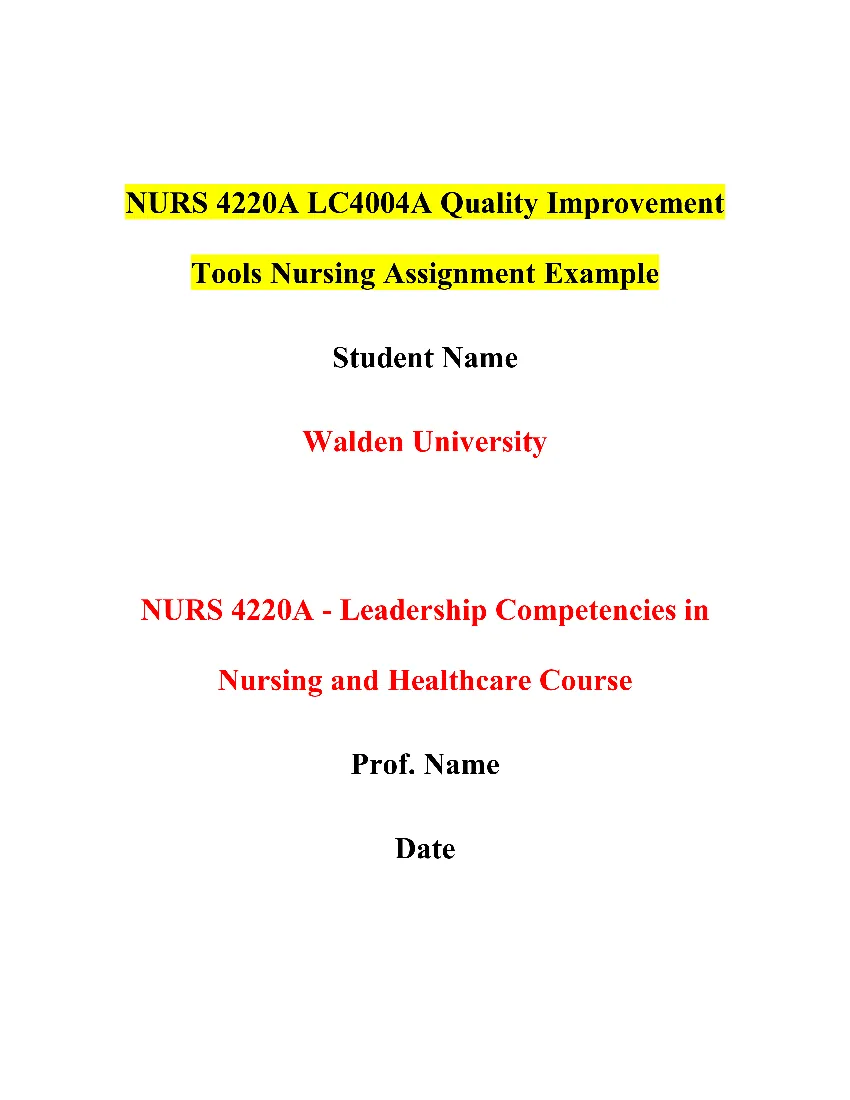 NURS 4220A LC4004A Quality Improvement Tools Nursing Assignment
NURS 4220A LC4004A Quality Improvement Tools Nursing Assignment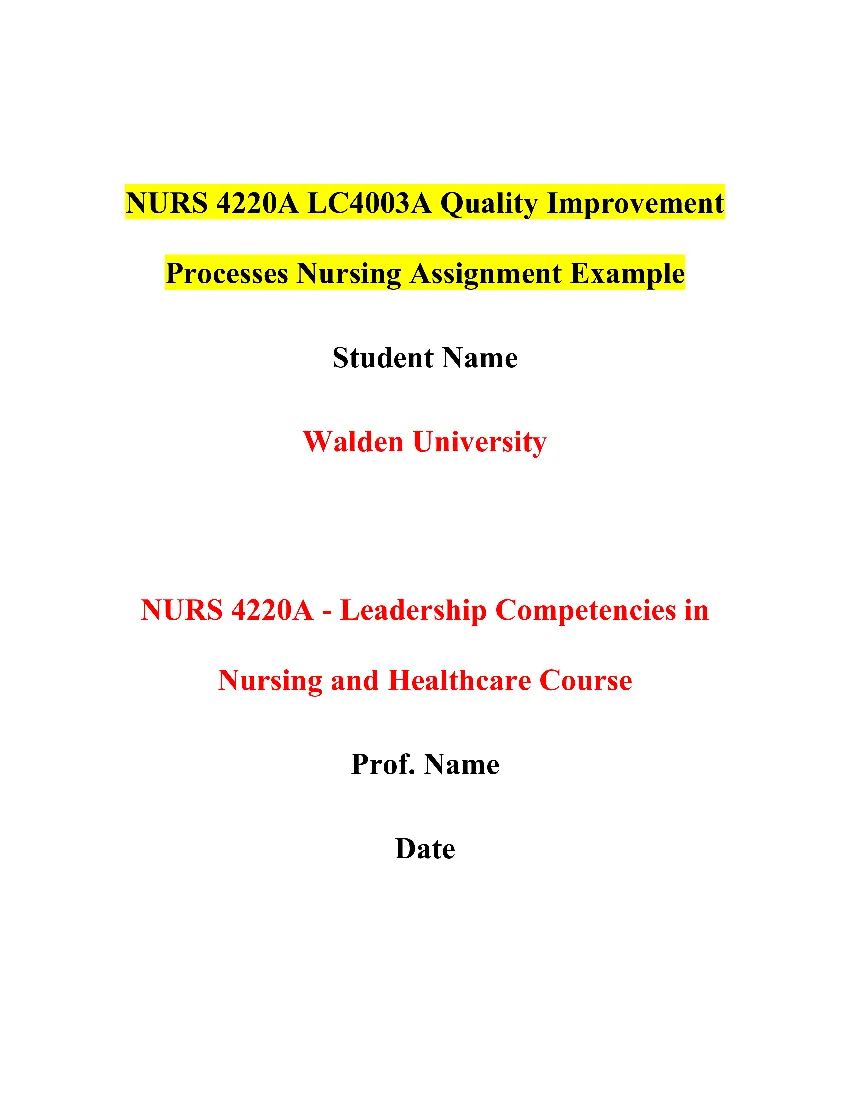 NURS 4220A LC4003A Quality Improvement Processes Nursing Assignment
NURS 4220A LC4003A Quality Improvement Processes Nursing Assignment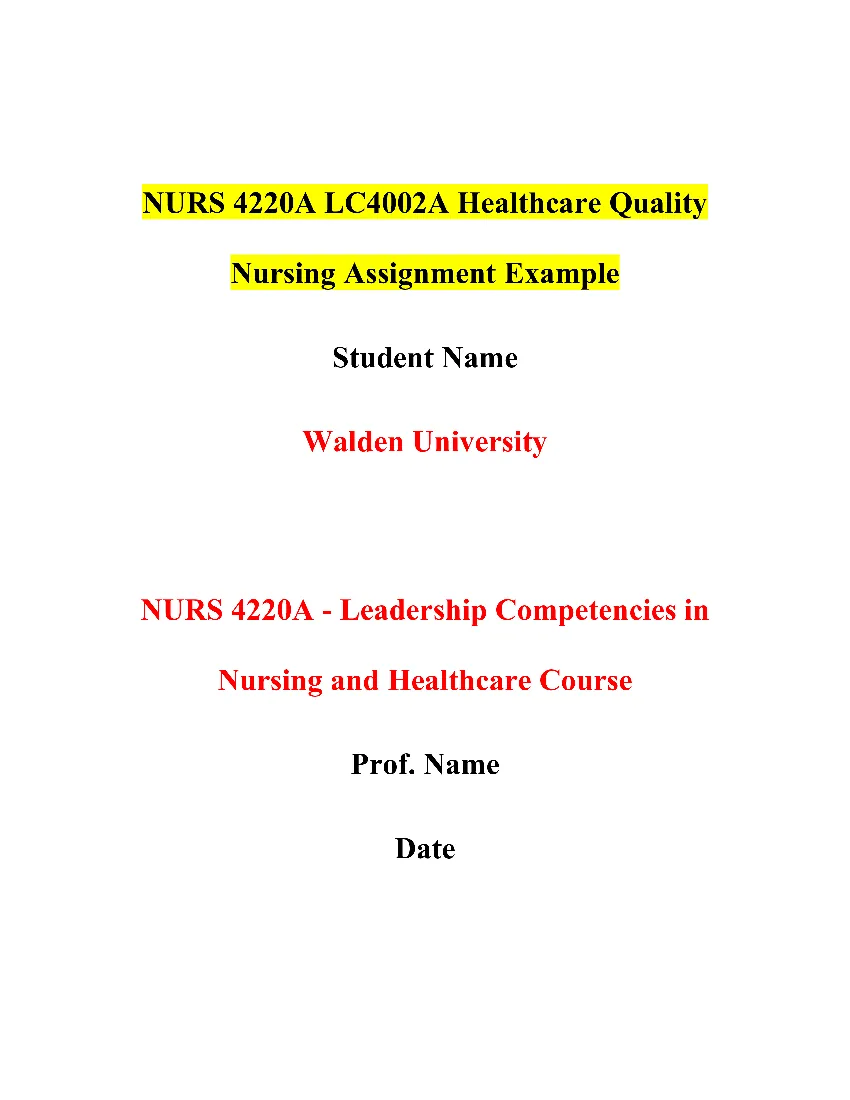 NURS 4220A LC4002A Healthcare Quality Nursing Assignment
NURS 4220A LC4002A Healthcare Quality Nursing Assignment NURS 4220A LC4001A Leadership for Organizational Culture and Growth Assignment
NURS 4220A LC4001A Leadership for Organizational Culture and Growth Assignment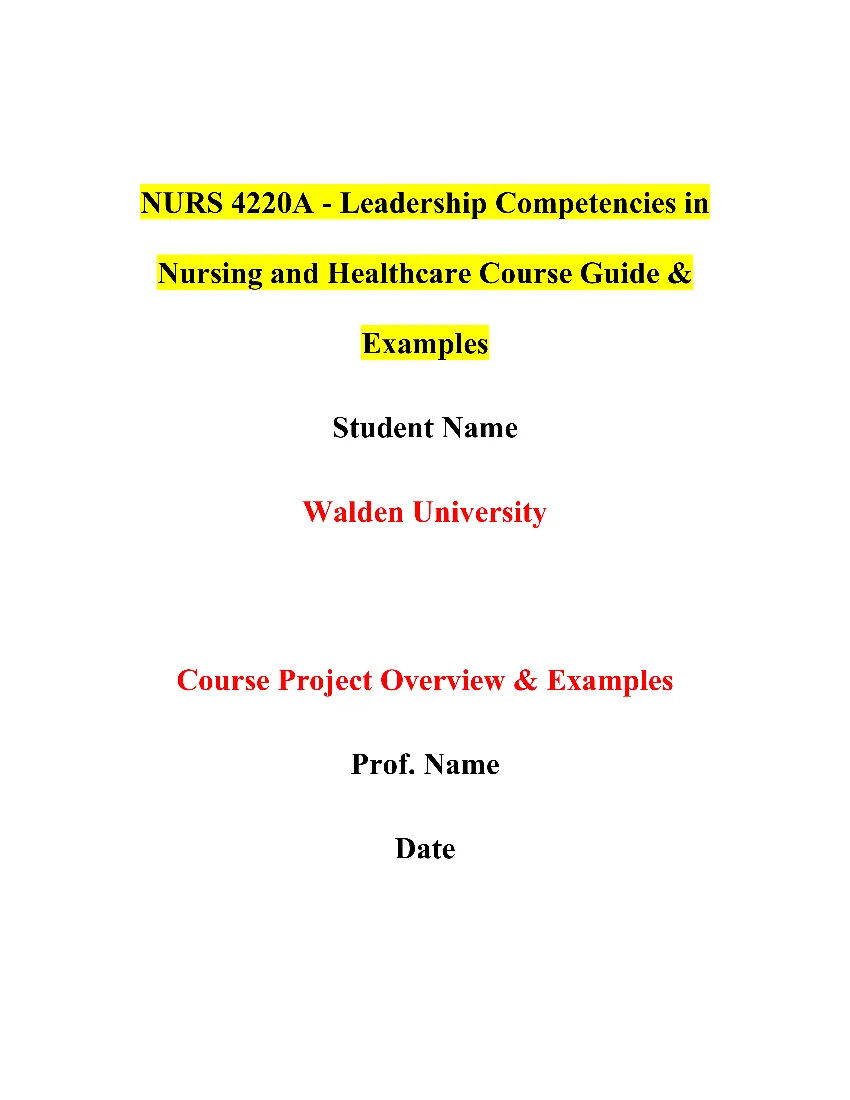 NURS 4220A – Leadership Competencies in Nursing and Healthcare Course Guide & Examples
NURS 4220A – Leadership Competencies in Nursing and Healthcare Course Guide & Examples NURS 4210 PH4005 Evidence-Based Intervention Plan Practicum Presentation Assignment
NURS 4210 PH4005 Evidence-Based Intervention Plan Practicum Presentation Assignment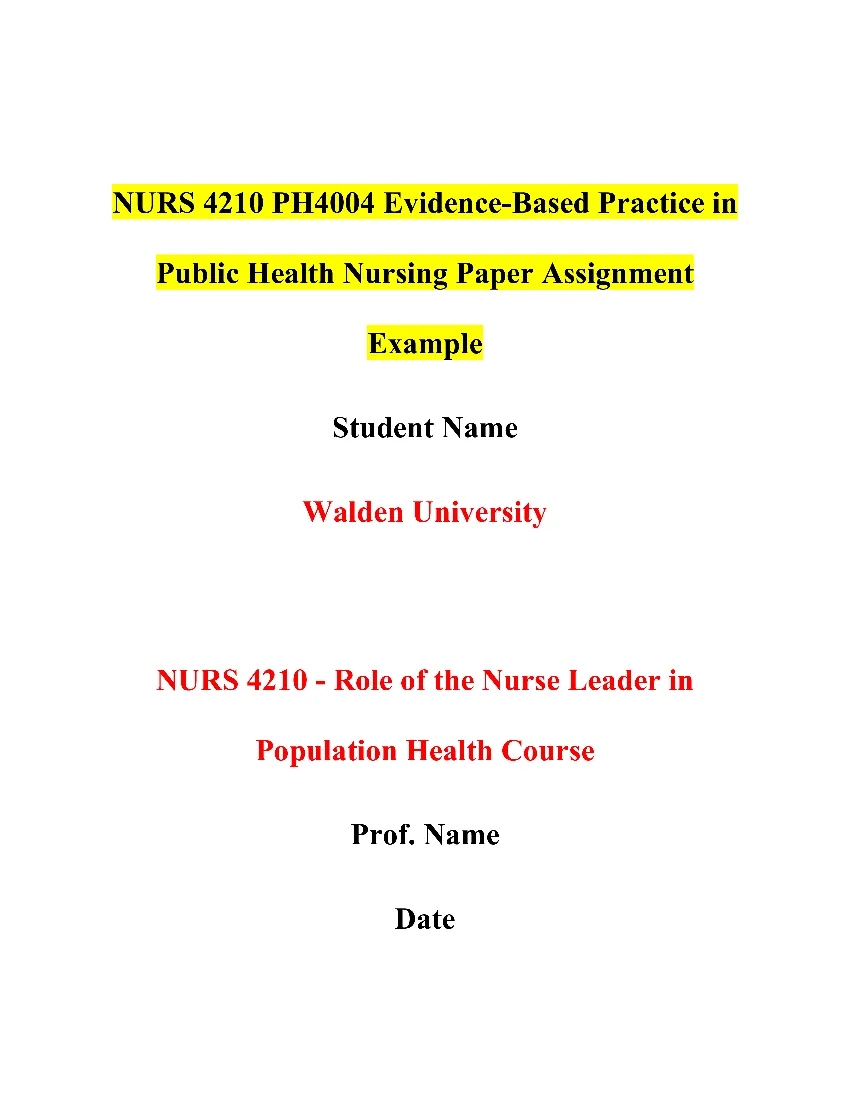 NURS 4210 PH4004 Evidence-Based Practice in Public Health Nursing Paper Assignment
NURS 4210 PH4004 Evidence-Based Practice in Public Health Nursing Paper Assignment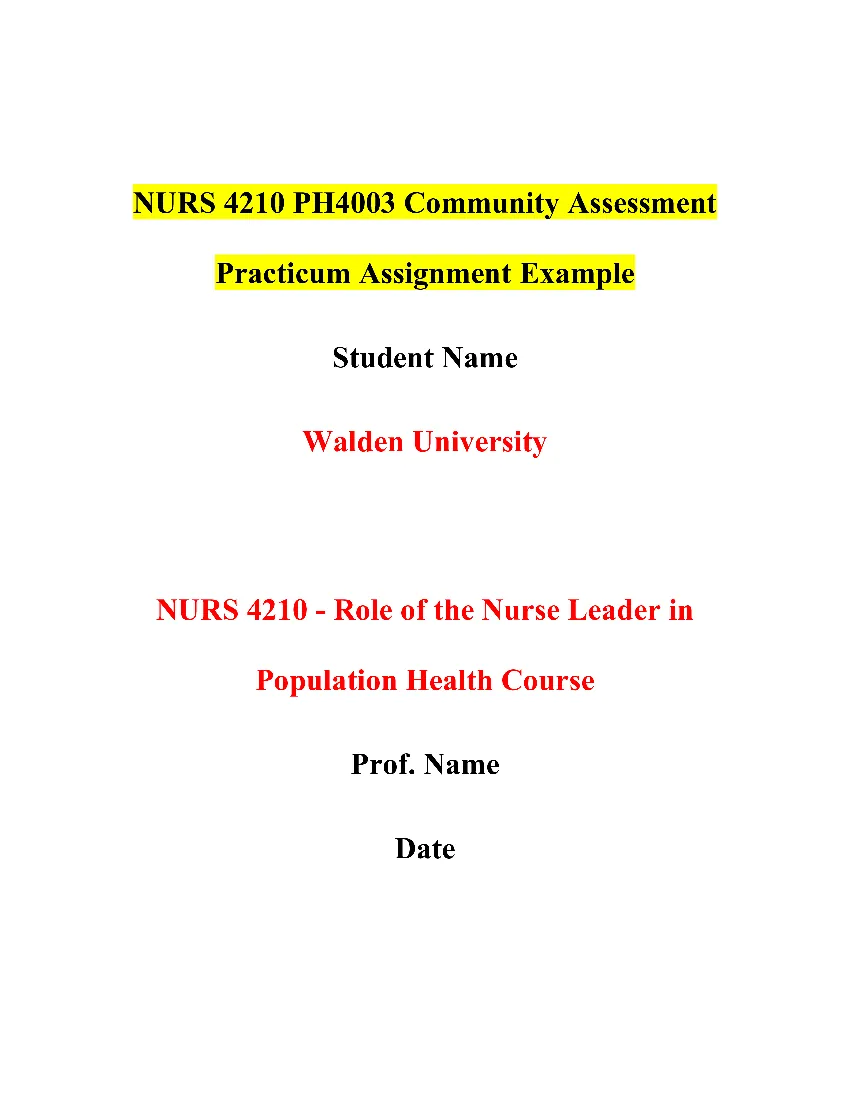 NURS 4210 PH4003 Community Assessment Practicum Assignment
NURS 4210 PH4003 Community Assessment Practicum Assignment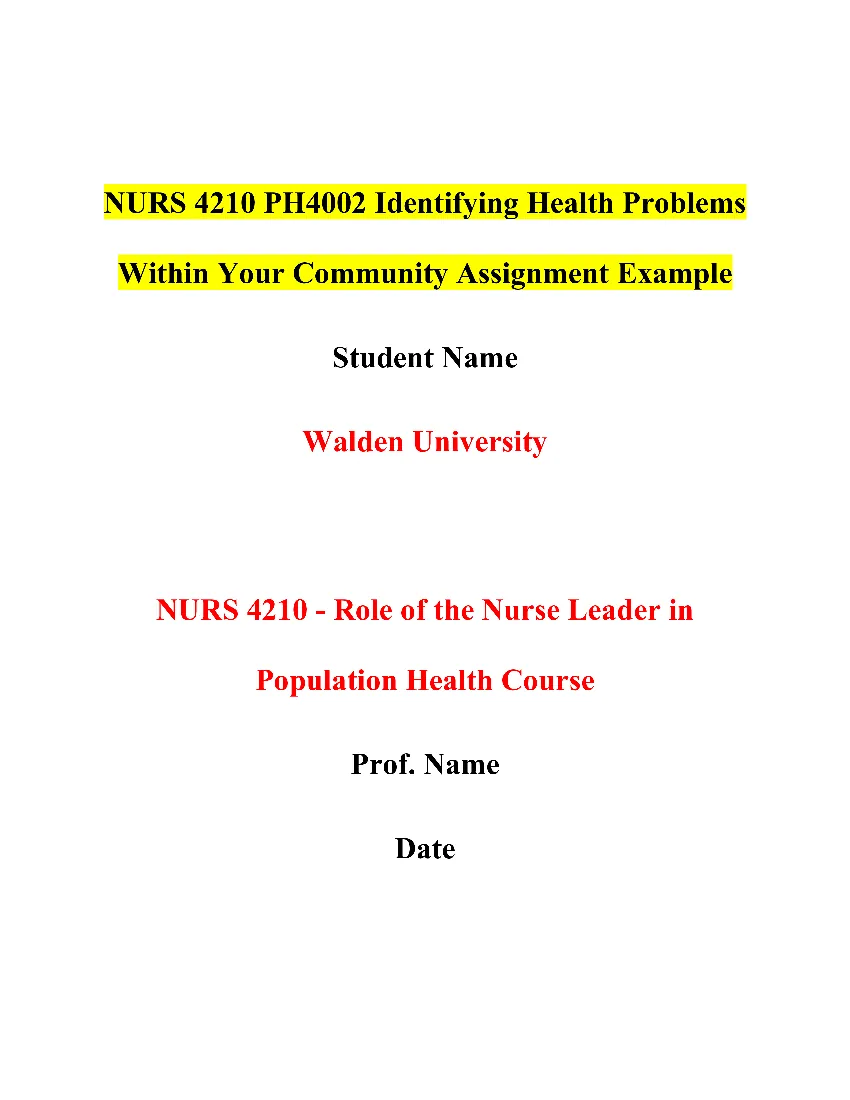 NURS 4210 PH4002 Identifying Health Problems Within Your Community Assignment
NURS 4210 PH4002 Identifying Health Problems Within Your Community Assignment